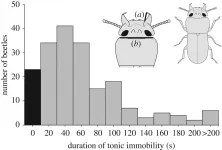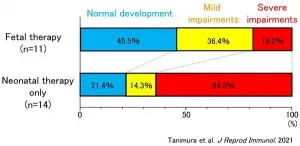Size matters: How the size of a male's weapons affects its anti-predator tactics
Scientists demonstrate in a species of beetle that males adopt different survival tactics depending on the size of their mandibles, which they use as weapons
2021-01-28
(Press-News.org) Across many animal species there is great evolutionary pressure on males, who often engage in combat for the rights to copulation. This phenomenon, called sexual selection, often ends up favoring males with larger weapons, such as horns or pincers. Interestingly, scientists have noted that males endowed with smaller weapons adopt alternative reproductive tactics in some species. For example, instead of fighting other more powerful males, they may try to sneak around or disperse in search of a lonely female.
Variability in sexual behavior according to a male's weapon size has been widely studied. However, it's worth noting that bigger is not always better. Though larger weapons usually help in fights for reproductive rights, they can also be a hinderance because they lower the animal's overall mobility. This has been proven in males of a species of Japanese rhinoceros beetle, who fall prey to predators more easily when their horns, which they use as weapons, are bigger. Could it be that, just as males with smaller weapons adopt alternative sexual tactics, males with larger weapons adopt different anti-predator strategies?
In a recent study published in Biology Letters, a team of scientists from Okayama University, Japan, proved that this is most likely the case. Led by Professor Takahisa Miyatake, they focused on a species of beetle called Gnathocerus cornutus, the males of which bear large mandibles as weapons for male-on-male combat. When threatened, G. cornutus exhibits two very distinct behaviors: escape or tonic immobility, also called death feigning. The team investigated whether differences in weapon size caused males to behave differently when faced by a predator.
They obtained nearly two hundred male G. cornutus beetles from a laboratory and conducted two types of experiments. First, they pitted male beetles against one of their natural predators, a jumping spider. When attacked by the spider, most beetles froze in place, which seemed to cause the spider to quickly lose interest. On the other hand, the beetles that tried to struggle or run away were repeatedly attacked by the spider and killed. These initial experiments proved that tonic immobility is a useful anti-predator strategy.
In the second series of experiments, the researchers measured the size of the mandibles of male beetles and then tried to get them to exhibit tonic immobility by gently touching their abdomen with a thin stick. Unlike previous behavioral studies, which exclusively focused on the duration of tonic immobility once triggered, the team also quantified the frequency of tonic immobility. Whereas no statistical relationship was found between weapon size and tonic immobility duration, a link was very apparent between weapon size and frequency; individuals with larger mandibles were generally more prone to exhibit tonic immobility when stimulated. Excited about the results, Dr. Kentarou Matsumura remarks: "For animals that fight with weapons, the costs of having larger weapons are well known. However, this is the first time we have scientifically determined that anti-predator tactics can vary among males according to their weapon size."
The results and the research strategy adopted by the team will help biologists unravel the mysteries of the evolution of behaviors, as Miyatake explains: "As the first study of predator-avoidance tactics in animals that have weapons for male-to-male fighting, we believe this is an opportunity to delve deeper on the relationship between the evolution of weapons and anti-predator behavior." Miyatake also states that these new discoveries will spawn a new research topic in the evolution of survival tactics, which in turn will increase our overall scientific understanding of this challenging field in the future.
What other fascinating evolutionary secrets could be hiding out there in the behaviors of different animals? Let us hope this study acts as a springboard for finding the answers!
INFORMATION:
[Attachments] See images for this press release:

ELSE PRESS RELEASES FROM THIS DATE:
2021-01-28
Blood is vital to life, and a healthy body replenishes worn-out blood cells with new ones throughout one's lifetime. If something goes wrong with this process, serious illness will result.
Researchers from the National University of Singapore (NUS) have now discovered a mechanism controlling the replenishment of blood cells, which could have relevance for new treatments for blood cancers and other blood-related diseases.
The international research team, helmed by Dr Akihiko Numata while he was a Postdoctoral Fellow in the laboratory of Professor Daniel Tenen of the Cancer Science Institute of Singapore and Yong Loo Lin School of Medicine ...
2021-01-28
Countries around the world are seeing a surge in the number of computer science students. Enrolment in related university programs in the U.S. and Canada tripled between 2006-2016 and Europe too has seen rising numbers. At the same time, the age to start coding is becoming younger and younger because governments in many different countries are pushing K-12 computer science education. Despite the increasing popularity of computer programming, little is known about how our brains adapt to this relatively new activity. A new study by researchers in Japan has examined the brain activity ...
2021-01-28
A cross-institutional research group has revealed for the first time in the world that infants with symptomatic congenital cytomegalovirus (CMV) infection who were treated with a combination of immunoglobulin fetal therapy and neonatal therapy with antiviral drugs were less likely to experience the severe aftereffects associated with the infection than those who only received the neonatal therapy.
It is hoped that the number of children suffering severe aftereffects resulting from congenital CMV infection will decrease in the future.
The research group included the following members:
Doctor YAMADA Hideto ...
2021-01-28
Tokyo, Japan -- In the marchland of Japan's Oze National Park, keeping track of the deer population has been a difficult and time-consuming task for the park rangers. Now their lives could get much easier, thanks to a novel technique for tracking deer movements using unmanned listening devices developed by researchers at the Institute of Industrial Science, a part of The University of Tokyo.
Monitoring deer numbers is important in Oze and other national parks in Japan because deer are not native to the ecosystem and can have damaging effects on it. Current methods of monitoring deer populations range from traditional techniques such as counting droppings to photographing deer at night using automated cameras or from above during the day using unmanned aerial vehicles ...
2021-01-28
Air pollution is a key risk factor for cardiovascular disease, and a major contributor to the global burden of disease. Long-term exposure to air pollution has also been linked to an increased risk of death from COVID-19. This dangerous "triple threat" of air pollution, COVID-19 and cardiovascular disease should be taken seriously, warn major health authorities.
Four leading cardiovascular organizations - the World Heart Federation (WHF), American College of Cardiology (ACC), American Heart Association (AHA) and European Society of Cardiology (ESC) - today released a joint statement urging the medical community and health authorities to mitigate the impact of air pollution on people's ...
2021-01-28
A Quebec research team has discovered two early plasma markers to detect Alzheimer's disease five years before its onset. The results of this recent study led by the doctoral student Mohamed Raâfet Ben Khedher and postdoctoral student Mohamed Haddad, directed by Professor Charles Ramassamy of the Institut national de la recherche scientifique (INRS), have been published in the prestigious scientific journal Alzheimer's & Dementia: Translational Research & Clinical Interventions (TRCI).
The diagnosis of Alzheimer's disease is usually based on a series of psychometric ...
2021-01-28
Support for policies prohibiting smoking and the use of tobacco products on Oregon State University's Corvallis campus grew substantially over a five-year span, especially among tobacco users, a recent OSU study found.
The study, published earlier this month in the journal Preventive Medicine, is unique in its analysis of support for smoke- and tobacco-free campus policies over a long period of time. Most other studies of attitudes toward smoking policies only assess a single point in time.
"Tobacco-free policies are one of the most effective things we can do to reduce the burden of tobacco use, and they are highly supported ...
2021-01-28
Navigating, exploring and thinking about space are part of daily life, whether it's carving a path through a crowd, hiking a backcountry trail or maneuvering into a parking spot.
For most of human history, the driving force for day-to-day wayfinding and movement across the landscape was a need for food. And unlike other primates, our species has consistently divided this labor along gender lines.
In new research published in Nature Human Behaviour, scientists including James Holland Jones of Stanford and lead author Brian Wood of University of California, Los Angeles, argue that the increasingly gendered division of labor in human societies during the past 2.5 million years dramatically shaped how our species uses space, and possibly ...
2021-01-28
A research team from HSE University and SkolTech, together with experts from the Smorodintsev Research Institute of Influenza in St. Petersburg and the RAS Kharkevich Institute for Information Transmission Problems (IITP), discovered that the SARS-CoV-2 virus independently entered Russia at least 67 times, mostly at the end of February and beginning of March 2020. The vast majority of introductions came from European countries. No cases of introduction from China were registered, which is likely due to the timely closure of borders with the country. Currently, nine local virus lineages are circulating in Russia, which are not present elsewhere in the world. Given that Russia was actively 'importing' the virus from abroad, the researchers have not detected any cases of 'exporting' ...
2021-01-28
ROCHESTER, Minn. -- In a new study published in Circulation, Mayo Clinic researchers provide the first preclinical, proof-of-concept study for hybrid gene therapy in long QT syndrome, a potentially lethal heart rhythm condition.
Researchers demonstrated its potential therapeutic efficacy in two in vitro model systems using beating heart cells reengineered from the blood samples of patients with 1 long QT syndrome. They targeted the whole KCNQ1 gene rather than specific LQT1-causative mutations, making this study applicable to all patients with long QT ...
LAST 30 PRESS RELEASES:
[Press-News.org] Size matters: How the size of a male's weapons affects its anti-predator tactics
Scientists demonstrate in a species of beetle that males adopt different survival tactics depending on the size of their mandibles, which they use as weapons



